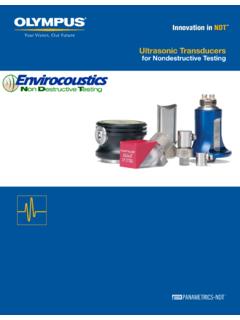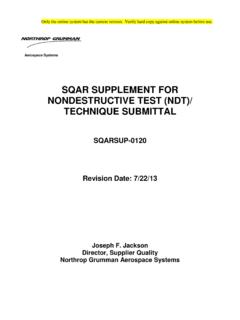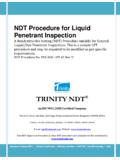Transcription of OPTIMIZING CONDENSER TUBE LIFE WITH …
1 OPTIMIZING CONDENSER TUBE life with nondestructive TESTING By Jeffrey Gamza, Marketing Specialist, Conco Systems nondestructive testing is an effective way to determine the lifespan of your CONDENSER and heat exchanger tubes . The results are analyzed and discontinuities or anomalies can be categorized and reported by defect type and depth. This provides management with an accurate assessment of unit condition and remaining useful life . Additionally, precautionary steps can be taken to plug damaged tubes or avoid any potential failures reducing costly CONDENSER tube leaks and preventing forced outages.
2 Caption: A qualified data acquisition technician inserts an eddy current probe into a tube for examination. EDDY CURRENT TESTING Eddy current testing is a well established form of nondestructive testing used to examine non ferritic tubing in condensers and heat exchangers. Tubing such as austenitic stainless steel, titanium, brass and copper nickel are often tested with eddy current methodology. The eddy current method is a volumetric testing process that uses an electromagnetic field to identify defects in the tubing. An electron flow (eddy current) is induced in electrically conductive material and an electromagnetic field is generated by a probe.
3 The probe is first placed in a standard and calibrated to known defects producing representative signals. The probe is then placed inside the tubing to be tested and pulled. Variations in the eddy currents are recorded and compared to those produced by the standard. Variations are caused by the frequencies applied, the characteristics of the material and any flaws or defects. An analysis on the results is performed following the tests; successful and accurate analysis is based on analyst experience, proper calibration to standard, and selection of frequencies.
4 Any defect or anomaly in the tubing that disrupts the flow of the eddy currents can be detected. Depending on the number of frequencies and channels used, defects with unique characteristics can be found. Small defects such as pitting and cracking can be detected in the differential mode. Wall thinning defects such as steam erosion or inlet end erosion are detected in the absolute mode. Additionally, higher frequencies are more sensitive to near surface flaws, and lower frequencies are more sensitive to subsurface flaws and conditions on the outer diameter (OD) tube surface.
5 The complex and varied nature of anomalies and defects necessitate the use of multiple frequencies for accurate identification. Caption: As a standard bobbin coil eddy current probe passes through the tube, the electromagnetic field (in green) is disrupted by a defect in the tube wall. Illustration courtesy of Zetec. MULTIPLE FREQUENCIES An essential element in the eddy current testing process is the use of multiple testing frequencies. A true volumetric inspection requires complete penetration of the tube wall from various perspectives; as prime frequency is set affording full wall penetration; additional frequencies are required to gain an accurate and detailed perspective of the defect.
6 Multiple frequencies offer the ability to better detect, measure, and confirm flaws in all areas of a tube wall and allow for a more thorough evaluation with higher confidence. In fact, additional frequencies are vital to confirm certain defects, such as under deposit corrosion and microbiologically influenced corrosion. A minimum of three frequencies is highly recommended to perform optimum testing. While present day eddy current testing instruments have the capacity to carry up to eight frequencies, at least three are utilized, or more commonly four, to gain a full perspective on the defect.
7 From the chosen optimum frequency, the alternate frequencies are usually and of the prime frequency for mixing out support plates and other unwanted signals from structures or noise. The optimum frequencies will vary from low, to midrange, to high depending on the material under test. Evaluation of inner diameter (ID) and outer diameter (OD) defects or varying size may also require different frequencies. Each frequency may be carried on two channels to further evaluate variations and in order to confirm the reading. Utilizing multiple frequencies in the testing process provides the analyst with sufficient information to call the defects with greater accuracy and reliability.
8 Utilizing a multi frequency test instrument and standard probes commonly used for testing CONDENSER tubes , tube samples with various defects will be examined utilizing one, two, three and four frequencies. Defect acquisition rates will also be varied and the results reported. The experience of the analyst is another important factor in the testing process. ECT technicians should be certified to (ASNT) SNT TC 1A guidelines. Additionally, level IIIA and senior level IIA analyst should have passed both Electric Power Research Institute s (EPRI) Data review and evaluation of balance of plant (BOP) Heat Exchangers class.
9 All analysts should have passed an industry approved data analysis level IIA class. Not only is it important to use multiple frequencies, it is essential to select the correct range or values. For an example of lower range frequencies consider 30 kilohertz (KHz), a typical prime frequency when testing admiralty brass tubes with .049 wall thickness, reducing to of prime or 15 KHz and even to of prime on the lower end of the range. For higher range frequencies consider testing of 304 stainless steel tubing with .028 wall thickness, the typical prime frequency may be 800 900 KHz, reducing to prime or 400 KHz and then to 200 KHz.
10 The number and value of frequencies also affects the rate at which defects can be detected. Though lower frequencies are preferred for copper alloys and subsurface flaws, they take longer to propagate reducing the speed at which acquisition can be performed. Uses of Multiple Frequencies High Frequencies Low FrequenciesUse Stainless Steels (.028) Near surface flaws ID Pitting Brass / Copper Alloys (.049) Subsurface Flaws Severe Pitting Range 800 to 900 KHz (High) 400 KHz (Mid) 200 KHz (Low) 30 KHz (High) 15 KHz (Mid) 7 to 8 KHz (Low) The use of fewer frequencies may expedite testing, but may result in less accurate results.




